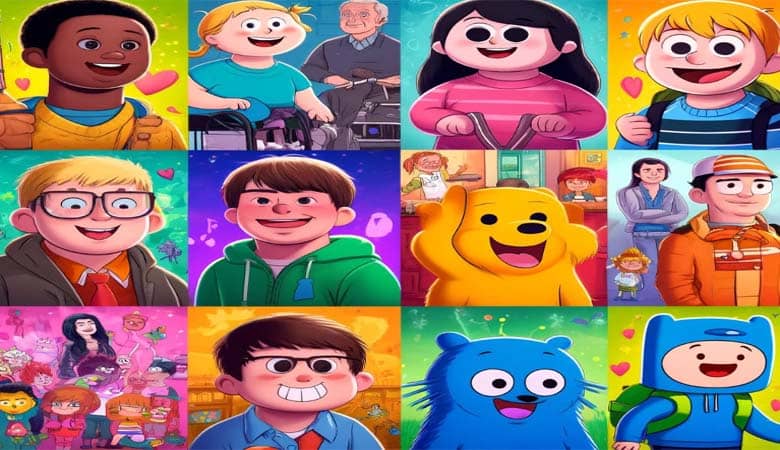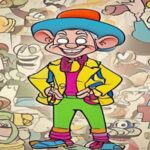Representation in media is crucial for fostering an inclusive society. Cartoon characters with Down syndrome not only entertain but also educate and inspire viewers by promoting diversity and acceptance. Here, we highlight 11 Down syndrome cartoon characters of all time, celebrating their presence and the positive impact they have on audiences.
Table of Contents
Carl from “Arthur”
Carl is a lovable character from the animated series “Arthur.” He is introduced as a friend of the main characters and has Down syndrome. Carl’s portrayal emphasizes his unique talents and friendly nature, helping to educate young viewers about the condition in a positive and inclusive manner.
Chris Burke’s Animated Self in “Life Goes On”
Though not a traditional cartoon, the character Chris Burke voices in the animated segments of “Life Goes On” deserves a mention. Chris Burke, an actor with Down syndrome, lends his voice to an animated version of himself. This character’s inclusion was groundbreaking, providing an authentic representation of Down syndrome.
Tracy from “Fireman Sam”
Tracy is a character from the popular children’s show “Fireman Sam.” She has Down syndrome and is depicted as an active and integral part of the community. Tracy’s character teaches children about acceptance and the importance of including everyone, regardless of their differences.
Sally from “The Specials”
“The Specials” is a British animated series featuring characters with various disabilities, including Down syndrome. Sally, one of the main characters, is a vibrant and energetic young girl who brings joy and positivity to the show. Her character is a testament to the capabilities and spirit of individuals with Down syndrome.
Patrick from “Sesame Street”
“Sesame Street” has always been at the forefront of promoting diversity and inclusion. Patrick is a character with Down syndrome who appears in several episodes. His presence helps normalize Down syndrome and educate children about it in a gentle and approachable way.
Maya from “The Amazing World of Gumball”
Maya is a minor character in “The Amazing World of Gumball” who has Down syndrome. Although she doesn’t appear frequently, her inclusion is significant. Maya’s character demonstrates that people with Down syndrome can be part of everyday life and contribute to the story just like any other character.
Liam from “The Loud House”
Liam is another character with Down syndrome featured in the animated series “The Loud House.” His character is portrayed as a kind and friendly individual who enjoys hanging out with his friends. Liam’s inclusion in the show adds depth to the cast and promotes the message of inclusion and friendship.
Sarah from “Doc McStuffins”
“Doc McStuffins” is a beloved children’s show known for its diverse characters. Sarah, a character with Down syndrome, is introduced in one of the episodes. She is depicted as a cheerful and creative girl, helping to break stereotypes and promote a positive image of individuals with Down syndrome.
Charlie from “My Friends Tigger & Pooh”
Charlie is a young boy with Down syndrome who appears in the show “My Friends Tigger & Pooh.” His character is portrayed as enthusiastic and imaginative, participating in adventures with the main characters. Charlie’s inclusion helps young viewers see the value of diversity and friendship.
Karla from “Nina Needs to Go!”
In the animated short series “Nina Needs to Go!”, Karla is a character with Down syndrome. She is shown as a supportive and caring friend to Nina. Karla’s character is a wonderful example of how individuals with Down syndrome can be depicted positively in children’s programming.
Finn from “Adventure Time” (Fan Theory)
While not officially confirmed, some fans speculate that Finn from “Adventure Time” displays characteristics of Down syndrome. This interpretation is based on his unique traits and behavior. Regardless of the show’s intention, this theory highlights the importance of diverse representation in media and the impact it has on viewers.
The Importance of Representation
Including characters with Down syndrome in animated series is vital for fostering a more inclusive society. These characters help to break down stereotypes, promote understanding, and teach children the value of acceptance and diversity. By seeing characters with Down syndrome on screen, viewers of all ages can learn to appreciate the unique qualities and contributions of individuals with this condition.
Conclusion
The inclusion of Down syndrome characters in cartoons is a step forward in creating a more inclusive and representative media landscape. Each character mentioned in this article plays a significant role in educating audiences and promoting a positive image of Down syndrome. As we continue to see more diverse characters in media, it is essential to celebrate and support these portrayals, ensuring that everyone feels seen and valued.
These 11 Down syndrome cartoon characters not only entertain but also inspire and educate, making them invaluable additions to the world of animation. By embracing diversity in media, we can create a more understanding and inclusive world for future generations.










